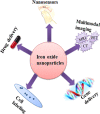Plant-based metallic nanoparticles as potential theranostics agents: bioinspired tool for imaging and treatment
- PMID: 30247124
- PMCID: PMC8675965
- DOI: 10.1049/iet-nbt.2017.0325
Plant-based metallic nanoparticles as potential theranostics agents: bioinspired tool for imaging and treatment
Abstract
Theranostic approach provides us a platform where diagnosis and treatment can be carried out simultaneously. Biosynthesis of theranostic-capable nanoparticles (NPs) can be carried out by phytoconstituents present inside the plants that can act as capping as well as stabilising agents by offering several advantages over chemical and physical methods. This article highlights the theranostic role of NPs with emphasis on potential of plants to produce these NPs through ecofriendly approach that is called 'Green synthesis'. Biosynthesis, advantages, and disadvantages of plant-based theronostics have been discussed for better understanding. Moreover, this article has highlighted the approaches required to optimise the plant-mediated synthesis of NPs and to avoid the toxicity of these agents. Anticipating all of the challenges, the authors expect biogenic NPs can appear as potential diagnostic and therapeutic agents in near future.
Figures






Similar articles
-
Green synthesis of silver nanoparticles via plant extracts: beginning a new era in cancer theranostics.Nanomedicine (Lond). 2016 Dec;11(23):3157-3177. doi: 10.2217/nnm-2016-0279. Epub 2016 Nov 4. Nanomedicine (Lond). 2016. PMID: 27809668 Review.
-
Green Synthesis of Gold Nanoparticles Using Plant Extracts as Beneficial Prospect for Cancer Theranostics.Molecules. 2021 Oct 22;26(21):6389. doi: 10.3390/molecules26216389. Molecules. 2021. PMID: 34770796 Free PMC article. Review.
-
Recent Developments in the Plant-Mediated Green Synthesis of Ag-Based Nanoparticles for Environmental and Catalytic Applications.Chem Rec. 2019 Dec;19(12):2436-2479. doi: 10.1002/tcr.201800202. Epub 2019 Apr 25. Chem Rec. 2019. PMID: 31021524 Review.
-
Plant-Based Synthesis of Gold Nanoparticles and Theranostic Applications: A Review.Molecules. 2022 Feb 18;27(4):1391. doi: 10.3390/molecules27041391. Molecules. 2022. PMID: 35209180 Free PMC article. Review.
-
Biogenic metallic nanoparticles: from green synthesis to clinical translation.Naunyn Schmiedebergs Arch Pharmacol. 2024 Nov;397(11):8603-8631. doi: 10.1007/s00210-024-03236-y. Epub 2024 Jun 27. Naunyn Schmiedebergs Arch Pharmacol. 2024. PMID: 38935128 Review.
Cited by
-
The Use of Medicinal Plant-Derived Metallic Nanoparticles in Theranostics.Pharmaceutics. 2022 Nov 10;14(11):2437. doi: 10.3390/pharmaceutics14112437. Pharmaceutics. 2022. PMID: 36365255 Free PMC article. Review.
-
Antimicrobial Activity of Silver and Gold Nanoparticles Prepared by Photoreduction Process with Leaves and Fruit Extracts of Plinia cauliflora and Punica granatum.Molecules. 2022 Oct 13;27(20):6860. doi: 10.3390/molecules27206860. Molecules. 2022. PMID: 36296456 Free PMC article.
-
Effects of Zinc, Copper and Iron Oxide Nanoparticles on Induced DNA Methylation, Genomic Instability and LTR Retrotransposon Polymorphism in Wheat (Triticum aestivum L.).Plants (Basel). 2022 Aug 24;11(17):2193. doi: 10.3390/plants11172193. Plants (Basel). 2022. PMID: 36079574 Free PMC article.
References
-
- Silva G.A.: ‘Introduction to nanotechnology and its applications to medicine’, Surg. Neurol., 2004, 61, (3), pp. 216 –220 - PubMed
-
- Iravani S.: ‘Green synthesis of metal nanoparticles using plants’, Green. Chem., 2011, 13, (10), pp. 2638 –2650
-
- Balasooriya E.R. Jayasinghe C.D. Jayawardena U.A. et al.: ‘Honey mediated green synthesis of nanoparticles: new era of safe nanotechnology’, J. Nanomater., 2017, 2017, (3), pp. 1 –10
Publication types
MeSH terms
Substances
LinkOut - more resources
Full Text Sources
Other Literature Sources

